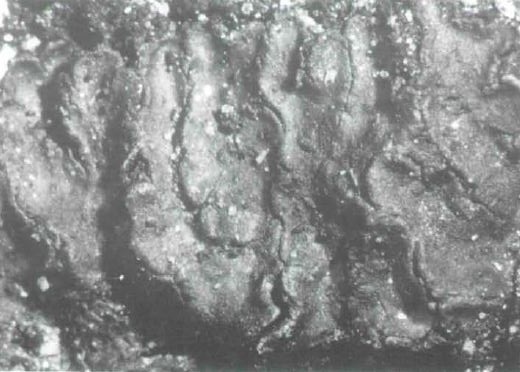Placidium norvegicum (Breuss) Breuss
Ann. naturhist. Mus. Wien, Ser. B, Bot. Zool,. 98 (Suppl.): 39, 1996.. Basionym: Catapyrenium norvegicum Breuss - in Breuss & Hansen, Pl. Syst. Evol., 159, 1-2: 100, 1988.
Synonyms:
Distribution:
Description: Thallus squamulose, medium to dark brown, matt or rarely slightly glossy in marginal parts, 350-550 μm thick. Squamules 3-6 mm wide, closely adpressed, contiguous but not overlapping, often forming rosettes. Lower surface black, attached by colourless (but brownish in the proximal zone), 6-8 μm thick rhizohyphae. Upper cortex 40-60 μm thick, paraplectenchymatous, with a thin epinecral layer; medulla thick, composed of up to 15 μm wide, globular cells; lower cortex clearly delimited, with roundish to polygonal, 11-15 μm wide cells, with brown pigment between cells. Perithecia black, broadly pyriform, up to 0.6 mm across, without involucrellum, immersed in the squamules. Exciple colourless to pale brown around the ostiole; paraphyses absent, periphyses 2-3 μm thick. Asci 8-spored, cylindrical, thin-walled, non-amyloid and without an ocular chamber. Ascospores 1-celled, hyaline, uniseriately arranged in the asci, ellipsoid, (15-)17-22 (-24) x (7.5-)8-10.5(-11.5) μm. Pycnidia black, laminal, immersed. Conidia bacilliform, (5-)6-7(-8) x 1.5-2, most of them 3-5 times as long as wide. Photobiont chlorococcoid. Spot tests: cortex and medulla K-, C-, KC-, P-, UV-. Chemistry: without lichen substances. Note: an arctic-alpine species of more or less calciferous soil, known from several scattered stations in the Alps (outside Italy) and from the mountains of the Iberian Peninsula. To be looked for in the Italian Alps.
Growth form: Squamulose
Substrata: soil, terricolous mosses, and plant debris
Photobiont: green algae other than Trentepohlia
Reproductive strategy: mainly sexual

Predictive model
Growth form: Squamulose
Substrata: soil, terricolous mosses, and plant debris
Photobiont: green algae other than Trentepohlia
Reproductive strategy: mainly sexual

Predictive model
 Index Fungorum
Index Fungorum
 GBIF
GBIF


